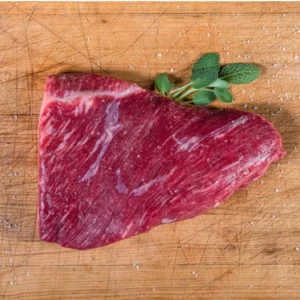
Where does the Tri-Tip steak come from?
Tri-Tip is a triangular cut of beef from the bottom portion of the sirloin. Tri-Tip is a lean cut that can become tough if not cooked and served correctly. The main reason for this is the grain patters. We preach about cutting against the grain, and this cut is no different. It has two distinct grain patterns – one that runs horizontally, and one that runs vertically. Cooked Tri-Tip must be sliced thinly and against the grain before serving to make it tender.

What’s in a name?
The Tri-Tip is named after its triangular shape with a tapered “tip”, it might just be one of the most flavorful cuts that you’ve never heard of. You might also hear it referred to as the bottom sirloin butt, a Newport Steak, or even a “poor man’s brisket”.
How do I cook it?
First, you’ll want to make sure you remove any ragged edges or any thick chunks of fat so you’re left with a lean, boomerang-shaped piece of meat. You’ll want to pat the cut dry with a paper towel before you apply any seasonings or marinades. This will help create less steam during cooking and allows the cut to sear easier and more evenly. Whether grilling, roasting, braising or any other cook type – you’ll want to sear each side on high heat first. This will help lock in the juices. After searing, you can slow cook to your desired level of doneness. We recommend medium-rare, so you’ll want to remove the cut once it reaches an internal temperature of 140°. Let it rest for at least five minutes before slicing. This allows the cut to continue cooking while the juices redistribute throughout the meat.
How do I cut it?
We’re not done yet! Take just as much time and care with cutting your Tri-Tip as you did with your preparation and cooking. The Tri-Tip can be a little tricky to slice, as it does have two different grain patterns. Approximately half of the steak contains muscle fibers that run vertically, while the other half contains muscle fibers that run horizontally. It’s easiest to cut the Tri-Tip into two pieces where those two grain patters meet (you can do this before or after cooking). On each piece, slice thinly against the grain. This will make for the most tender slices.
If you’re not trying the lesser-known cuts of meat you’re seriously missing out. By branching out and trying other cuts of meat, you’re blessed with the best of both worlds. Not only are you greeted with a more affordable price, but you’re also treated to unbelievable flavors.
The story of the Tri-Tip the same as the Roseda story – you have to taste it to believe it!